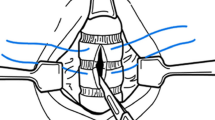Abstract
Children swallow coins more than any other object. Many methods for removal of impacted coins at the upper end of the oesophagus are enumerated in literature, each having it’s own merits and demerits. This retrospective study in 100 consecutive paediatric patients presents a magill forcep technique for removal of coins under inhalational anaesthesia using Mc-Intosch laryngoscope. Intubation and rigid endoscopy both were avoided, thereby minimizing hospital stay and cost of treatment. This also decreases the chances of complications. Moreover the technique was found to be at par with rigid endoscopy in term of efficacy and safety. However interestingly statistical analyses of the data by ‘Chi SquareTest’ (ξ 2) revealed the technique to be more applicable in younger age group i.e. 0–6 years.
Similar content being viewed by others
References
Murrey AD, Mahoney EM, Holinger LD. Foreign Bodies of the airways and esophagus. In:Cummings CW ed: Otolaryngology and Head-Neck Surgery. Mosby, St Louis, 1998;378.
Empirical methods for categorical data. In: Armitage P, Berry G, Mathews JNS ed: Statistical Methods In Medical Research. Blackwell Science, London, 2002; 512–516.
McGahren ED (1999) Esophageal foreign bodies. Pediatr Rev 20:129–133
Calkins CM, Christians KK, Sell LL (1999) Cost analysis in the management of esophageal coins, endoscopy versus bougienage. J Pediatr Surg 34:412–414
Conners GP, Chamberlain JM, Ochsenschlager DW (1995) Symptoms and spontaneous passage of esophageal coins. Arch Pediatr Adolesc Med 149:36–39
Gauderer MWL, DeCou JM, Abrams RJ, et al. (2000) The penny pincher: a new technique for fast and safe removal of esophageal coins. J Pediatr Surg 35:276–278
Campbell JB, Foley LC (1983) A safe alternative to endoscopic removal of blunt esophageal foreign bodies. Arch Otol Laryngol 109:323–325
Conners GP (1997) A literature based comparision of pediatric esophageal coin removal. Pediatr Emerg Care 13:154–157
Pharynx. In: Standring S ed: Grays Anatomy-The Anatomical Basis Of Clinical Practice. Elsevier Churchill Living-Stone, London, 2005; 631
Schleien CL, Kuluz JW, Shaffner DH, et al. (1992) Cardiopulmonary resuscitation. In: Rogers MC ed: Textbook of pediatric intensive care, Williams & Wilkins, Baltimore, 3–51
Ehrensperger C, Gross J, Hempel V, et al. (1992) The modified magill forceps. Anaesthetist 4:218–220
Quinones RF, Saez MM, Serrano EMP, et al. (1995) Magill forceps: A vital forceps. Pediatr Emer Care 11:302–303
Mahafza TM (2002) Extracting coins from the upper end of the esophagus using a magill forceps technique. Intr J of Pediatr Otorhinolaryngol 62:37–39
Author information
Authors and Affiliations
Corresponding author
Rights and permissions
About this article
Cite this article
Singh, G.B., Aggarwal, D., Mathur, B.D. et al. Role of magill forcep in retrieval of foreign body coin. Indian J Otolaryngol Head Neck Surg 61, 36–38 (2009). https://doi.org/10.1007/s12070-009-0031-7
Published:
Issue Date:
DOI: https://doi.org/10.1007/s12070-009-0031-7




